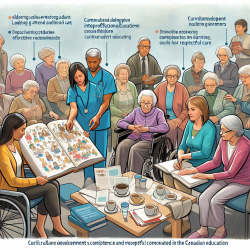Children with severe speech and physical impairments (SSPI) face unique challenges in developing connected speech, particularly when their ability to produce functional speech is significantly limited. Traditional theories of language acquisition emphasize the role of language production in learning grammar, suggesting that children learn to construct grammatical sentences by practicing and receiving feedback on their speech. However, some children with SSPI may develop connected speech later in childhood, missing the rapid linguistic growth phase typical between ages two and six. This raises an important question: How can these children acquire grammatical knowledge if their language production experiences are limited?
A groundbreaking study titled "Connected Speech Development in a Child with Limited Language Production Experience" by Ann Sutton, PhD, from McGill University and Mackay Center in Montreal, Quebec, offers valuable insights into this question. The research focuses on a child with SSPI who developed connected speech after the age of five, providing a unique opportunity to explore the expressive syntax and grammatical knowledge acquisition from primarily language comprehension experiences.
The study's findings reveal that despite the late onset of connected speech, the child demonstrated syntactic development at a rate that matched or even exceeded typical developmental progress. This suggests that language comprehension experiences can significantly contribute to the acquisition of grammatical knowledge, even in the absence of early language production. These results support comprehension-based views of language acquisition and challenge the notion that language production is a critical component of learning grammar.
For practitioners working with children with limited language production, this research highlights the importance of focusing on language comprehension activities alongside efforts to encourage speech production. Here are several strategies derived from the study's outcomes that can help enhance speech therapy practices:
- Rich Language Environment: Create a language-rich environment that exposes the child to a wide range of grammatical structures and vocabulary. This can include reading stories, engaging in conversations about the child's interests, and incorporating language modeling in daily activities.
- Use of AAC Systems: Augmentative and alternative communication (AAC) systems can provide children with a means to participate in communication exchanges, even before the development of connected speech. Practitioners should explore a variety of AAC options to find the most suitable system that complements the child's comprehension abilities and encourages active participation.
- Focus on Comprehension: Develop activities that enhance language comprehension skills, such as following directions, answering questions about stories, and identifying objects or actions in pictures. These activities can build a foundation for grammatical knowledge that supports later expressive language development.
- Parent and Caregiver Involvement: Encourage parents and caregivers to be active participants in the child's language development process. Providing training and resources can empower them to reinforce language comprehension and production skills in the home environment.
- Collaborative Approach: Work collaboratively with other professionals, such as occupational therapists and special educators, to create an integrated approach to language development. This can ensure that the child's comprehensive needs are addressed and that language learning opportunities are maximized across different settings.
The study by Sutton et al. opens new avenues for understanding the complex interplay between language comprehension and production in children with SSPI. By implementing strategies focused on enhancing language comprehension, practitioners can support the development of connected speech and grammatical knowledge in children with limited language production experiences.
It's crucial for practitioners to stay informed about the latest research and adapt their practices to incorporate evidence-based approaches. Continuing education, professional development opportunities, and collaboration with researchers can help practitioners refine their methods and improve outcomes for children with speech and language impairments.
To read the original research paper, please follow this link: Connected Speech Development in a Child with Limited Language Production Experience.










